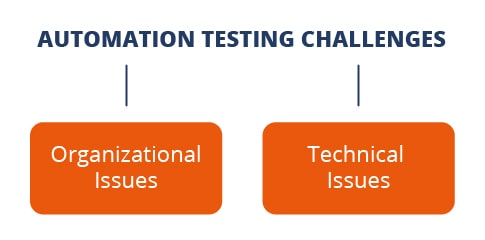- QATestLab Blog >
- Automated Testing >
- The Most Common Test Automation Challenges
Note: the article was updated in September 2020.
We test software to have confidence that it will work as it should. We also want the testing process to be effective at finding all the hidden bugs, efficient, quick, and cheap (of course).
Automating software testing can significantly reduce the effort required for the adequate outcome, and increase the coverage attainable in limited time. Tests that would otherwise take hours to run manually can be performed in minutes.
Many challenges may come up in trying to automate testing. Most problems can be overcome, and this article is intended to help you deal with them.
Test Automation: Top Challenges You May Face
Besides the benefits that you get implementing test automation (test coverage scaling, efforts reduction, time-saving, etc.), you should be ready for difficulties that may arise at different stages of its implementation.

Organizational issues in Test Automation
Difficulties connected with the process of setting up the automation testing are no less important than the technical ones as these are people who control the process. Among the most popular organization challenges at the project there are:
1. Poor client relation. It is rather challenging to accomplish tasks on test automation if there is no feedback from the client:
2. No team interaction. Specialists on test automation usually have different levels of qualification and experience, that is why it is very important to share ideas and not to be afraid to ask questions. Managers at such projects should have a clear understanding of the process of test automation with no false expectation and misconception that may lead a project to the failure.
3. Lack of input information. Roadmaps on software behavior, specification on its functionality, and desired behavior are necessary to set up the autotests for this product. In case of lack or absence of this information, the process of automation testing will be performed blind and won’t bring the expected results.
Technical challenges in Automation Testing
Technical difficulties are often connected with the tools used on the project, the product under testing, test maintenance, etc. Let’s check the most typical of them:
1. Frameworks limitation. Some types of software are rather difficult to cover with autotests because of their nature:
2. Testing tools instability. Technical issues often arise because of the tools used for test automation. Even if a tool is paid, it doesn’t guarantee that there are no faults in it and the tests will pass without crashes.
3. Changing functionality. It is natural to release new versions of software, but if the releases are too frequent (several times a year), it is difficult to maintain autotests as it requires much time and money.
How to avoid problems during Automation Testing?
Speaking about organizational challenges, smooth communication is the best way out.
- Test automation should be well supported by management and implemented into the organizational culture
- There should be time allocated training, experimenting, and learning what works best
- Standards are needed to ensure consistent ways of using the tools in the organization
As for technical issues, thorough preparation is a must to avoid them. This includes studying of a software under test, its specifications, roadmaps on its behavior, etc. It is also important to choose the right tool that will correspond to the maximum of the project needs. Among the prior tasks is choosing the specialists with the necessary qualification level and experience of work on similar projects. All their skills should be considered while choosing the methodology for project management.
You can also learn about the potential advantages of game test automation.
Learn more from QATestLab
Related Posts:
- QA Automation Tools: Low-Code, No-Code, or Coding-Based?
- Initiating Automation Testing in the Digital Era: Decoding Its Significance and the Wisdom of Vendor Collaboration
- When Does Your Project Need Test Automation?
About Article Author
view more articles
has 3-year experience in blogging, technical writing, and copywriting.
View More Articles







